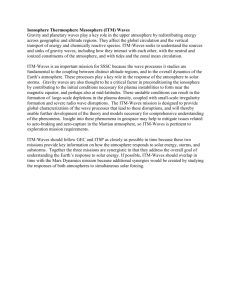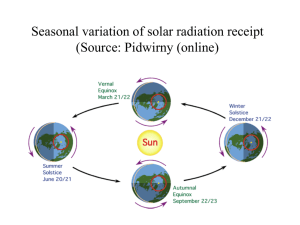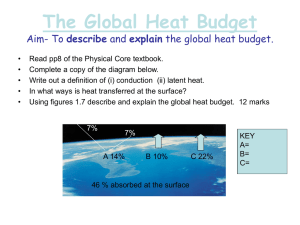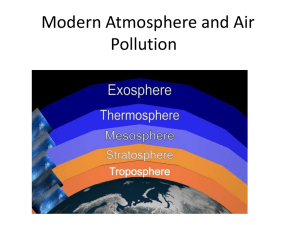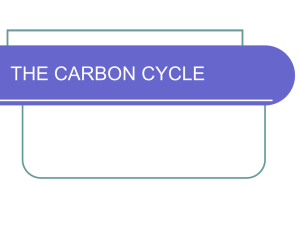Chapter 22 Study Notes ppt
advertisement
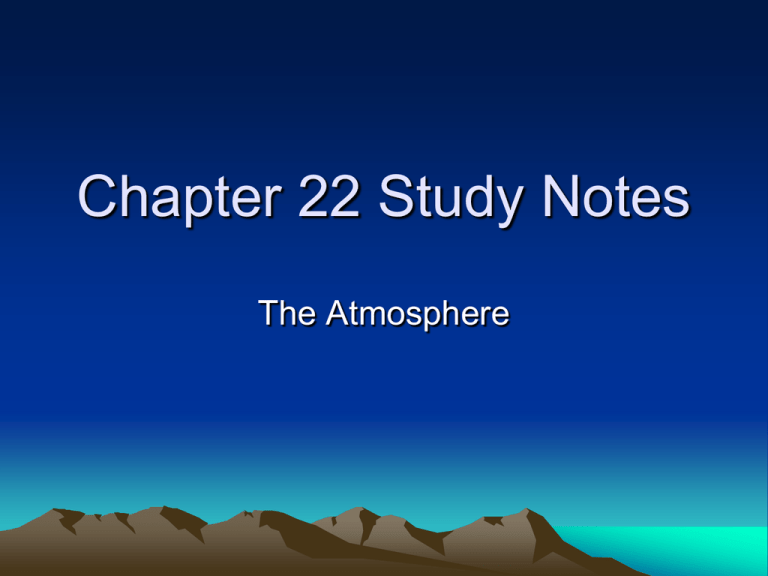
Chapter 22 Study Notes The Atmosphere Chapter 22 Section 1 Characteristics of the Atmosphere atmosphere is a mixture 1. The __________ of______, gases primarily nitrogen, oxygen, and argon, that surrounds Earth. compounds 2. The two most abundant __________ in the atmosphere are ______ carbon ______ dioxide and water vapor. 3. One effect of air pollution is destruction ozone ____. layer ________ of the _____ salt and pollen are all 4. Dust, ____, particulates in the atmosphere. __________ 5. Atmospheric pressure is barometer measured with a ________. troposphere is the lowest 6. The __________ layer of the atmosphere, where all weather conditions exist. _______ stratosphere is the layer of 7. The __________ the atmosphere which contains the ______ ozone layer. mesosphere is the coldest 8. The __________ layer of the atmosphere in which temperature decreases as altitude increases. thermosphere is the uppermost 9. The ___________ layer of the atmosphere ; includes the ionosphere. 10. Interactions between solar radiation ionosphere cause auroras and the __________ ______. inversions can 11. Temperature _________ intensify the effect of smog when cool, polluted ground air is trapped by warm air. 12. One harmful effect of inversions is _______. temperature ________ smog Chapter 22 Section 2 Solar Energy and the Atmosphere 13. Energy from the sun travels to radiation Earth as _________. spectrum is 14. The electromagnetic _______ all of the frequencies or electromagnetic wavelengths of _____________ radiation. 15. The solar radiation least absorbed by the layers of the atmosphere before reaching Earth is ______ visible ______. light Albedo is the fraction of solar 16. _______ radiation reaching Earth that is reflected. Solar radiation that is not 17. _____ reflected back into the atmosphere absorbed by surface materials. is _________ infrared rays that 18. After Earth absorbs ________ heat the ground, thermal energy is absorbed _______ by the atmosphere from the _________. ground 19. The warming of the surface and lower atmosphere of Earth that occurs when carbon dioxide, water vapor, and other gases in the air trap heat near Earth’s surface is known as the ____________ greenhouse ______. effect 20. A _____ delay between Earth’s absorption of solar energy and an increase in temperature makes the warmest part of a day in the ________. afternoon _______ Conduction is the transfer of 21. _________ energy as heat through a material. Convection is the movement of 22. _________ matter due to differences in density caused by temperature variations. Chapter 22 Section 3 Atmospheric Circulation Coriolis ______is Effect 23. The ______ the curving of the path of a moving object from an otherwise straight rotation path due to Earth’s ________. Coriolis 24. Because of the _______ Effect _______, an object that travels north from the equator will curve to the right. 25. Convection ________ cells are the three looping patterns of air flow that exist in each hemisphere. Prevailing winds that blow 26. ________ through the middle of the United States are called _________. Westerlies 27. The _____ trade winds of the Northern and Southern Hemispheres meet at the equator in a narrow zone of weak doldrums variable winds called __________. 28. The narrow bands of highspeed winds that blow in the upper jet streams atmosphere are called ___ ______. Local winds are influenced by 29. _____ local conditions _______ and local temperature. Land breezes blow cool air 30. ____ from _____ land to water. _____ THE END!!!

